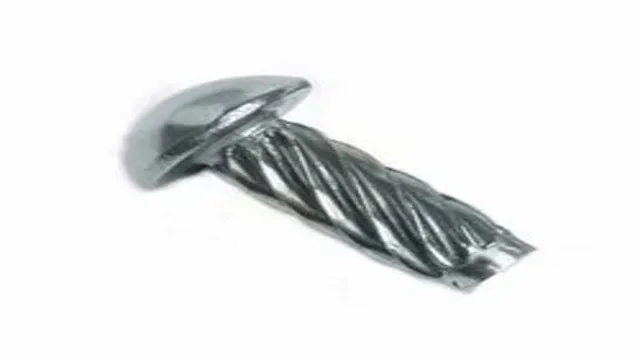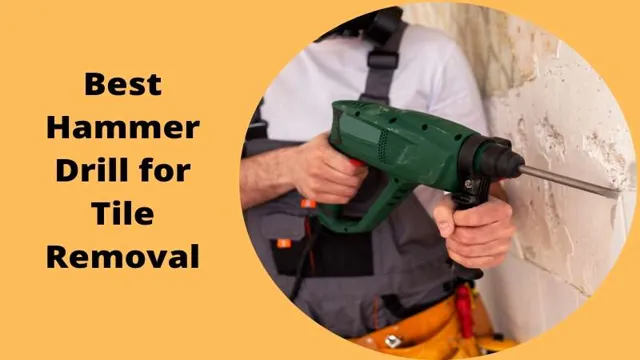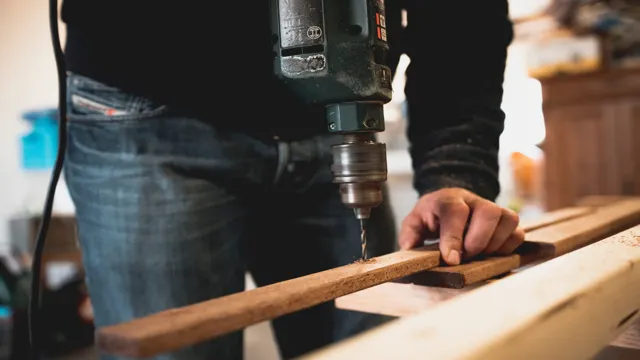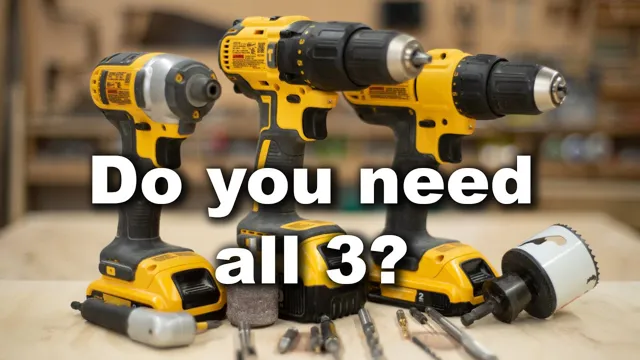Can I use a hammer drill to mix mortar? Tips and tricks for efficient mixing.
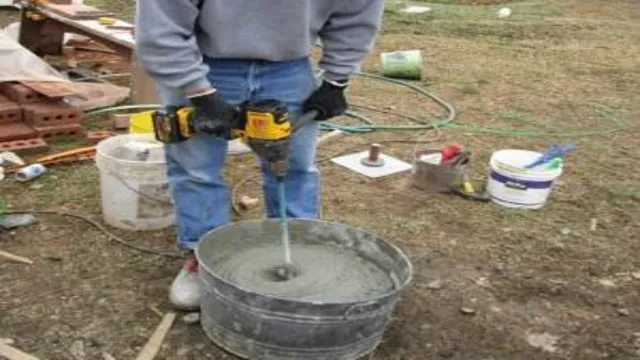
Mixing mortar is not usually an easy task, and sometimes traditional mixing methods do not produce the desired results. But, fortunately, there’s a device that can make mortar mixing a breeze: the hammer drill. This tool is widely known for its power and efficiency when it comes to drilling and making holes, but it is also a great alternative to traditional mixing tools when it comes to mixing mortar.
If you’re a homeowner or a DIY enthusiast who needs to mix mortar for a home renovation project, then you’re in luck. In this article, we’ll show you the benefits of using a hammer drill for mixing mortar, and how it can make your job easier and faster. So, grab your safety glasses and let’s get started!
What is a Hammer Drill?
A hammer drill is a powerful tool designed for drilling through tough materials like concrete, brick, and stone. With its unique hammering motion, the drill is able to break up hard surfaces while also drilling through them. However, can a hammer drill be used to mix mortar? The answer is yes, but only in certain situations.
If you’re mixing small batches of mortar, a hammer drill with a mixing attachment can be a good option for getting the job done quickly. However, for larger batches, it’s best to use a dedicated mortar mixer. Using a hammer drill for mixing large batches of mortar can cause the drill to overheat and wear out prematurely.
So, while a hammer drill can be a useful tool for mixing mortar, it’s important to use it wisely.
Definition and Features
A hammer drill is a powerful tool that is used to drill through hard surfaces such as concrete, masonry, and tile. It works by combining the functions of a drill and a hammer, allowing it to drill through materials that a regular drill would struggle with. The hammer drill has a special mechanism that causes it to deliver a series of blows as it turns, creating a more efficient drilling process.
The main feature of a hammer drill is its versatility, making it suitable for a wide range of applications, including construction, home improvement, and DIY projects. It can be equipped with various accessories, such as chisels and bits, making it one of the most versatile power tools on the market. Whether you’re a professional or a DIY enthusiast, a hammer drill is an essential tool to have in your toolbox.
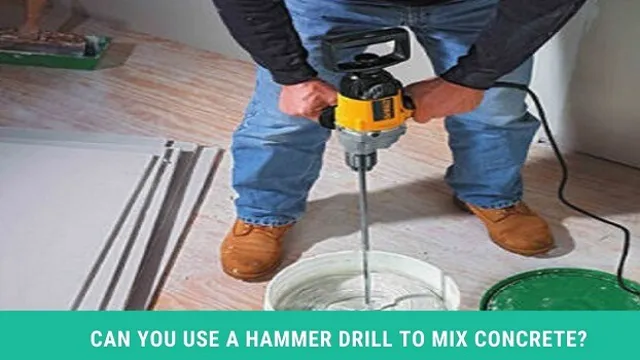
Types of Hammer Drills
A hammer drill is a very handy tool that can really make a difference in your DIY projects or even in a construction site. It is a power tool specifically designed for drilling into hard surfaces such as brick, concrete, and stone. What sets a hammer drill apart from a regular drill is that it uses a pulsing mechanism that helps to create a hammering motion.
This makes it much easier and faster to drill deeper and wider holes in tough materials. There are two types of hammer drills, namely the rotary hammer drill and the hammer drill driver. Rotary hammer drills are typically more powerful and can handle more heavy-duty tasks, such as chiseling and breaking up concrete.
Hammer drill drivers, on the other hand, are more compact and lightweight, making them a great choice for small home improvement projects. When choosing a hammer drill, it is important to consider your specific needs and the materials you will be working with to ensure you get the right tool for the job.
Can a Hammer Drill be Used for Mixing Mortar?
If you’re wondering whether you can use a hammer drill to mix mortar, the answer is yes! Hammer drills are versatile tools that can be used for a variety of tasks, including mixing mortar. However, you need to make sure that you use the right type of mixing paddle for the job. A regular drill bit won’t work for mixing mortar, as it doesn’t have the right shape or strength.
Instead, you need to use a mixing paddle that’s specifically designed for mortar mixing. These paddles have a wider base and a more aggressive mixing action, which is necessary for getting the mortar to the right consistency. Keep in mind that mixing mortar can be a challenging task, especially if you’re working with a large volume of materials.
So, it’s always a good idea to take breaks and make sure that you’re not putting too much strain on the drill or yourself. With the right tools and techniques, you can use a hammer drill to mix mortar with ease and efficiency.
Factors to Consider
A hammer drill can be a useful tool for drilling through tough materials like concrete, but can it be used for mixing mortar? The short answer is yes, but there are some factors to consider before using a hammer drill for this task. First, the size of the drill bit is important as it will affect the amount of torque generated when mixing the mortar. A larger drill bit will produce more torque, which can make the mixing process more efficient, but it can also make it more difficult to control.
Second, the speed of the hammer drill should be adjusted to a low setting when mixing mortar to prevent the mixture from splattering and creating a mess. Third, it’s important to use the correct mixing attachment for the job, such as a paddle mixer that can attach to the end of the drill bit. Lastly, keep in mind that while a hammer drill can be used for mixing mortar, it may not be the most efficient or effective option, so it’s important to weigh the pros and cons before proceeding.
Advantages and Disadvantages
A hammer drill is a powerful tool that is commonly used for drilling into hard surfaces such as concrete or brick. However, many people wonder if it can also be used for mixing mortar. The answer is yes, a hammer drill can be used for mixing mortar, but it is not the ideal tool for the job.
The advantage of using a hammer drill for mixing mortar is that it is a powerful tool that can quickly and effectively mix the mortar. However, there are also several disadvantages to using a hammer drill for this purpose. First, the drill can overheat and burn out if it is used for too long or if the mixture is too thick.
Second, it can be difficult to control the speed of the drill, which can lead to an uneven mix. Finally, the drill can be quite noisy and can create a lot of dust, which can make it uncomfortable to use for extended periods of time. In general, it is best to use a dedicated mixer for mixing mortar, as this will provide a much more consistent and controlled mix.
Safety Precautions
When it comes to DIY home improvement projects, safety should always be the top priority. While a hammer drill is a versatile tool that can be used for a variety of tasks, it is important to understand its limitations to avoid any accidents or injuries. Using a hammer drill for mixing mortar, for example, is not recommended as it can cause the tool to overheat and damage the drill itself.
Instead, it is best to stick to a traditional mortar mixer to ensure a smooth and consistent mixture. Remember, taking the time to use the right tool for the job and following all safety precautions is key to a successful and safe project.
Alternative Tools for Mixing Mortar
If you’ve ever found yourself wondering if you can use a hammer drill to mix mortar, the answer is yes, but it’s not the recommended tool for the job. While a hammer drill has the power to mix mortar, it lacks the necessary speed of a dedicated mortar mixer and can result in a less-than-perfect mix. Instead, consider using alternative tools such as a drill paddle attachment, a mixing hoe, or a mixing drill.
A drill paddle attachment can be attached to a regular power drill and is designed specifically for mixing large quantities of mortar. A mixing hoe is a hand tool that can be used for smaller batches of mortar, while a mixing drill is similar to a hammer drill but with higher speeds and specialized paddle attachments for mixing. Ultimately, using the right tool for the job will result in a better quality mix and save you time and frustration in the long run.
Recommended Mixing Tools
When it comes to mixing mortar, there are a variety of tools that can be utilized for the task. While a traditional trowel and bucket may work in some instances, there are alternative tools that can make the job easier and more efficient. One popular choice is a power mixer, which can speed up the blending process and ensure consistent results.
Another option is a mixing paddle attachment for a drill, which can also help to save time and energy. For smaller jobs, a handheld mortar mixer can be used, which is especially useful for mixing in tight spaces or on uneven surfaces. Ultimately, the choice of mixing tool will depend on the specific job at hand and the preference of the individual doing the work.
Regardless of the method chosen, it is important to always follow proper safety protocols and use the appropriate protective gear.
Pros and Cons
When it comes to mixing mortar, there are a variety of tools available for the job. While some may prefer the traditional method of using a hoe and bucket, others may opt for a more modern approach such as using a drill and mixing paddle. One common alternative tool for mixing mortar is a mortar mixer.
These machines can save time and effort on larger projects, but they also require a larger initial investment and may take up more space on the job site. Another option is a mortar box, which is essentially a large container used for mixing mortar by hand. This can be a more affordable and portable option, but it may not be as efficient as other tools.
Ultimately, the choice of tool will depend on the individual’s specific needs and preferences.
Conclusion
In conclusion, while a hammer drill may seem like a tempting option for mixing mortar, it’s important to remember that it’s not always the right tool for the job. Mortar requires a particular consistency and mixing technique that a hammer drill may not be able to provide effectively. So, next time you’re tempted to use a power tool for mixing, remember the wise words of a seasoned DIY-er: if you want your mortar to be rock solid, stick to the tried and true methods of mixing by hand.
Hammer drills are great for making holes, not for making mashed potatoes!”
FAQs
What is a hammer drill used for?
A hammer drill is typically used to drill into hard surfaces such as concrete, brick, and stone.
Can a hammer drill be used to mix mortar?
Yes, a hammer drill can be used to mix mortar, but it is not the most efficient method as it may damage the drill’s motor or overheat the mixing paddle.
What is the best tool to use for mixing mortar?
A mortar mixer or a drill with a dedicated mixing paddle is recommended for mixing mortar as it can handle the thick and heavy consistency of the mixture.
How do I properly mix mortar?
To properly mix mortar, add the appropriate amount of water to the mixing container, then slowly pour in the dry mix while mixing continuously until a smooth and uniform consistency is achieved.
Can I mix mortar by hand?
Yes, mortar can be mixed by hand, but it can be difficult and physically demanding due to the thickness and weight of the mixture.
How long should I mix mortar for?
Mortar should be mixed for at least 3-5 minutes to ensure all the ingredients are evenly combined and a consistent texture is achieved.
What is the ratio of water to dry mix for mortar?
The ratio of water to dry mix for mortar may vary depending on the manufacturer’s instructions, but a common ratio is 3:1 (three parts dry mix to one part water). It’s important to follow the specific ratio listed on the packaging.

